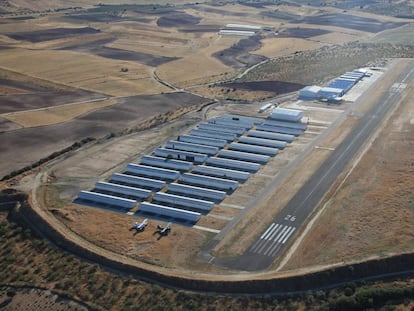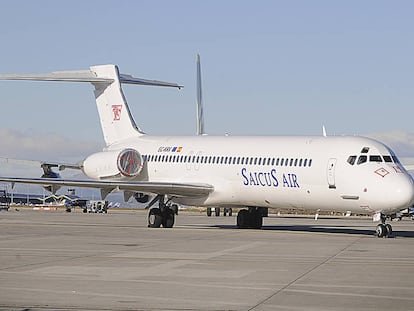How a group of homeless people found a place to live in Madrid airport
Posing as travelers who have been robbed or lost their documents, many of these “ghost travelers” have been living in Barajas’ terminals for years
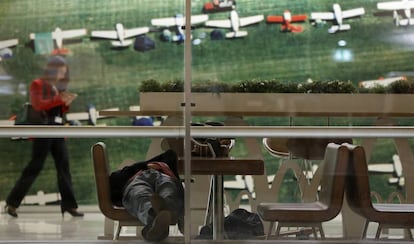

The passengers of Emirates flight EK144 to Dubai wait in line to check in their designer suitcases. Ladies in expensive dresses and men in suits and ties wait in line, as though they were about to attend a cocktail party and not a six-hour overnight flight. The monotony of the routine is interrupted when a man with a briefcase begins to desperately search in his jacket pockets.
“I’ve lost my wallet, my documents,” he says, flustered, in English. Incredulous faces stare at him. Embarrassed, the man turns around, grabs his case and walks away, passing beneath the large ceiling dome of Madrid-Barajas Adolfo Suárez Airport’s T4 terminal. In the next hour, the man will circulate the terminal four times, stopping a number of travelers to tell them the same story of his missing documents. When he feels he is being watched, he’ll pretend to make a phone call.
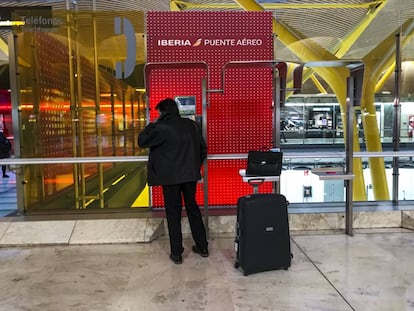
Anastasius, also known as El Griego (The Greek), is the most famous ghost traveler in Madrid’s airport. He is around 50 years old and wears a black leather jacket, black shirt and has a brand-new looking suitcase with his name on the side. For airport workers, El Griego has become such a permanent part of the airport’s landscape, he is no longer seen. He has been living in the terminal for at least five years and is part of a group of homeless people who pose as travelers – in his case a traveler who has just been robbed – in order to pass undetected.
Unlike the homeless people who carry large bundles with them and sleep in the long hallways that connect T2 and T3, ghost travelers blend in with the crowd by traveling light and carrying old boarding passes left behind by passengers. They try to collect a few euros by asking people for money to make a phone call to their family or the embassy. A young man who spent some time with El Griego says the pair would walk between 16 and 18 kilometers a day, according to his tracking wristwatch, which he later had to pawn.
The free bus service that connects the terminals allows ghost travelers to go anywhere and everywhere. They’ve memorized flight schedules and have discerned which flights are the most profitable. Although there are days that don’t work out, El Griego, who speaks some French and is fluent in English, always tries his luck at the Dubai check-in counter after the London and New York ones.
Some bus drivers are able to identify the ghost travelers because they are the only people, aside from airport workers, who get off at T3. Agustín, a driver who does the same route every day at least a dozen times, says he is able to identify them the third time he sees them. From T3, the ghost travelers walk two kilometers to reach the town of Barajas, where they go to buy things at reasonably priced supermarkets. If they’ve managed to collect the €27 needed for a room with a bathroom in a modest hostel, they’ll spend the night.

The McDonald’s restaurant at T4 is a meeting point for the ghost traveler community. It is cheap, serves large portions and no one bothers them there. David, dressed in a light brown suit jacket, red-checked shirt and hat (which he later sells for €30), has been sitting at a table outside the restaurant for three days in a row. He tells those who will listen that he missed his flight to Tel Aviv and has been waiting for a family member to send him the code for a new ticket. He says he sleeps little, which is why he is more nervous than usual, and feels stranded (“Yes, like Tom Hanks in that film [The Terminal]”).
The most mysterious ghost traveler is a 56-year-old known as El Japonés (The Japanese) or Del Chelsea (The Chelsea guy) after the tracksuit he wears from the London soccer team. He began living at the airport eight years ago after making a series of unfortunate business decisions and has been there ever since.
In the afternoon, El Japonés sits down at a McDonald’s table and connects his tablet to the WiFi (which he says is not very good) to watch kung fu videos, movies and documentaries on YouTube.
At night, he sleeps on the ground in a corner of the terminal beside a window looking over the runways. He wakes up every morning at 6am and goes directly to the bathroom to wash his face and teeth. Afterwards, he goes to a spot where he can usually find breakfast boxes put out by hotels for guests who leave before the buffet opens.
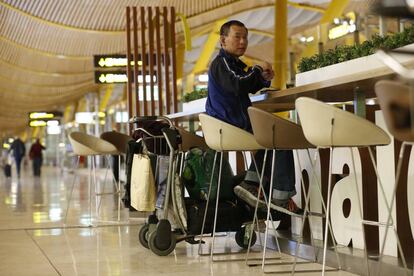
After breakfast, he tries to make a living that doesn’t involve “stealing, asking or threatening.” He acts as a guide. He looks for passengers in a hurry with oversized suitcases, and offers them one of the big shopping bags he carries with him. He’ll even offer to wrap passengers’ suitcases in plastic to protect them. He has also helped translate for the airport police when Japanese travelers find themselves in trouble.
El Japonés has not stepped foot outside of the terminal for a year-and-a-half. The other ghost travelers say he has connections because store workers will often offer him free coffee and food. He complains about the fact that the Spanish airline Iberia cancelled their subscription to the Financial Times, a newspaper he loved to read even though, he admits, it shows a vision of the world very different to his own. He has thought about leaving the airport in the past, but has since lost interest in the idea. When asked if he could see himself spending the rest of his life in the airport, he responds: “Yes, why not? It could happen.”
Madrid airport’s homeless community
Between 20 to 30 people are currently living in Adolfo Suárez Madrid-Barajas, according to the calculations EL PAÍS made during the four days it visited the airport. The National Police, which is charge of airport security, has identified the homeless people but their press department did not want to offer more details on their activities. Officers say the community does not represent any threat to public safety.
Spain's airport authority Aena says the homeless people have access to the terminals because they are public spaces. It explains that the airport works with City Hall social services to act "as efficiently as possible" to address cases of social exclusion. Although the airport authority did not offer any official figures, it says that a growing number of people are choosing to go to welfare centers.
In February 2019, the airport recorded more than four million passengers, an increase of 5.9% upon 2018 figures from the same month.
A ghost traveler who wanted to be known as "No Name" has spent eight months in the airport terminal. The man, who says he is from Israel, told his story to a woman from London who asked him, "Where do you want to go?" He replied that he would like to work as a fisherman in the Canary Island of Lanzarote. She then bought him a Ryanair ticket and sent it to him. The date of the flight was March 20. It's not known whether he was on board.
English version by Asia London Palomba.
